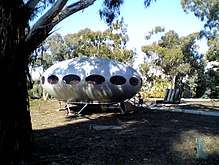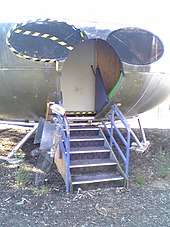Futuro
A Futuro house, or Futuro Pod, is a round, prefabricated house designed by Matti Suuronen, of which fewer than 100 were built during the late 1960s and early 1970s. The shape, reminiscent of a flying saucer, and the structure's airplane hatch entrance has made the houses sought after by collectors. The Futuro is composed of fiberglass-reinforced polyester plastic, polyester-polyurethane, and poly(methyl methacrylate), measuring 4 metres (13 feet) high and 8 metres (26 feet) in diameter.

History
The Futuro house was a product of post-war Finland, reflecting the period's faith in technology, the conquering of space, unprecedented economic growth, and an increase in leisure time. It was designed by Suuronen as a ski cabin that would be "quick to heat and easy to construct in rough terrain". The end result was a universally transportable home that had the ability to be mass replicated and situated in almost any environment.

The material chosen for the project — fiberglass-reinforced polyester plastic — was familiar to Suuronen and was previously used in the design of a large plastic dome for the roof of a grain silo in Seinäjoki. To facilitate transport, the house consisted of 16 elements that were bolted together to form the floor and the roof. The project could be constructed on site, or dismantled and reassembled on site in two days, or even airlifted in one piece by helicopter to the site. The only necessity on site for its placement were four concrete piers, so the project could occupy nearly any topography. Due to the integrated polyurethane insulation and electric heating system, the house could be heated to a comfortable temperature in only thirty minutes, from −29 to 16 °C (−20 to 60 °F).[1]
An excerpt from a February 1970 copy of Architecture d’aujourd’hui describes “Futuro” as:
the first model in a series of holiday homes to be licensed in 50 countries, already mass-produced in the United States, Australia and Belgium. The segments of the elliptic envelope are assembled on the site using a metal footing. Through its shape and materials used, the house can be erected in very cold mountains or even by the sea. The area is 50 sq m, the volume 140 cubic m, divided by adaptable partitions.
By the mid-1970s, the house was taken off the market. From the beginning, it had been met with public hostility. Their avant-garde appearance and unfamiliar materiality influenced the public’s reluctance to accept the Futuro House.[2]
The first Futuro House that was erected near Lake Puulavesi in Finland elicited public protest because it looked too unnatural for the rustic environment. In the United States, Futuro Houses were banned from many municipalities by zoning regulations. Banks were reluctant to finance them. Some were vandalized. Some customers who committed to buy them backed out and forfeited their non-refundable $1,000 deposits.[3] Some have been destroyed. In 1999, the city of Tampa ordered a Futuro House demolished.[4] Shortly after the turn of the century, a Futuro House was purchased on Broadkill Beach, Delaware, and destroyed to make way for a double-wide modular home. Some have been vandalized in drive-by shootings.[3]
The oil crisis of 1973 led to an abrupt halt in plastic production. Synthetics became very expensive to produce. Additionally, the public was shifting their view of plastics from a miracle material to an ecological concern. These problems provide context to the discontinuation of the Futuro House. Fewer than 100 were made and it is estimated that today around 60 of the original Futuro Houses survive,[5] owned mostly by private individuals. The prototype (serial number 000) is in the collection of Museum Boijmans Van Beuningen in Rotterdam, The Netherlands. The Futuro no. 001, the only other Futuro currently in a public collection, is in the possession of the WeeGee Exhibition Centre in Espoo, Finland.[6]
There are approximately 63 confirmed Futuro Houses in existence across the world. They are in Australia, Denmark, Estonia, Finland, France, Germany, Greece, Japan, The Netherlands, New Zealand, Norway, Republic of Crimea, Russia, Sweden, South Africa, Taiwan, United Kingdom, and the United States of America. [7]
Conservation

In 2010, Finnish conservator Anna-Maija Kuitunen made a damage assessment plan for the first Futuro ever made (serial number 001). This was done as her final thesis for the Metropolia University of Applied Sciences in Finland ("Futuro no. 001 – documentation and evaluation of preservation need"). The thesis is openly available via the Finnish Theses database and contains a large number of indoor detail photographs and drawings of the Futuro House.[8]
A UK artist, Craig Barnes, purchased and restored a Futuro house in 2013 – 14.[9] He had discovered the wreck whilst on holiday in South Africa and had it shipped back to the UK before commencing restoration. The Futuro house — the only one in the UK — was on display to the public as part of an exhibition on the rooftop of Matt's Gallery, London (until December 2014); the house was featured on the fourth series of the Channel 4 programme George Clarke's Amazing Spaces (Ep. 2[10]).
One Futuro house was found to be biodegrading by cyanobacteria and archaea.[11][12]
Marketing & Media
The Futuro home was primarily marketed towards young adults as an avant-garde retreat. Their promotion emphasized the versatility of the home in different locations and excerpt from a Playboy Magazine[13] advertisement reads, “The FUTURO’s steel-legged base is adaptable to virtually any terrain, from flatground to a 20 degree incline [...] Ideal for Beach, Skiing, Mountain areas and commercial uses.” However, a key limitation to this narrative was the need for electricity and plumbing to be installed in order for the structure to be fully habitable. Many surviving structures have been retrofit to allow for these needs and as a result the form Suuronen intended is compromised[14].
Uses
The Futuro House has had many departures from its intended use as a ski chalet.
New Zealand
Two Futuro Houses were transported to Christchurch New Zealand for the 1974 New Zealand British Commonwealth Games. These structures, referred to as "Space Banks"[15], were used by the Bank of New Zealand as a temporary banking structure. Following the games the Futuro Houses were put up for sale.[16]
United States of America
Futuro Homes in the USA were manufactured by the Futuro Corporation of Philadelphia. Some still stand today and many of these structures existed in New Jersey.
At least nine standard Futuro Houses and one Futuro House with 8 windows were constructed in New Jersey, USA in the 1970s to 1980s. Unfortunately, many did not last past the 1980s and were demolished. These pods were installed mostly in shopping centre parking lots. At least one of each model served as small-scale bank branches.[15] It is important to note that the use of these Futuro houses are likely due to zoning regulations at the time that would make it difficult to live in one. [17]
Documentary
In 1998, Finnish film director Mika Taanila made a short documentary film Futuro — A New Stance For Tomorrow about the Futuro house.[18]
See also
References
- Marko Home & Mika Taanila (eds.): Futuro: Tomorrow's House from Yesterday. Desura 2002. ISBN 952-5339-13-0
- Bucquoye, Moniek (2002). From bakelite to composite. Gent: Stitching Kuntsboek. pp. 164–165. ISBN 90-5856-086-4.
- Eyewitness account of Hudson Management in Lewes, DE 19958
- "Futuro Home - Southwest corner of Semmes and Juneau St's., Tampa, Florida". Futurohouse.com. Retrieved 2014-01-02.
- Papworth, Jill (3 November 2015). "Welcome to the Futuro house". The Guardian. Retrieved 17 November 2015.
- "Exhibition Centre WeeGee > Futuro house". Weegee.fi. Retrieved 2014-01-02.
- "The Futuro House - Current & Past Location Information - The Complete List - Information, Photographs, History, Maps". thefuturohouse.com. Retrieved 2020-04-03.
- Anna-Maija Kuitunen: Futuro no. 001 – documentation and evaluation of preservation need. 2010, Metropolia University of Applied Sciences, Finland.
- "Futuro". Retrieved 31 October 2014.
- "George Clark's Amazing Spaces - Episode Guide". Channel 4. Retrieved 31 October 2014.
- Andrea Rinaldi (November 7, 2006). "Saving a fragile legacy. Biotechnology and microbiology are increasingly used to preserve and restore the world's cultural heritage". EMBO Reports. 7 (11): 1075–1079. doi:10.1038/sj.embor.7400844. PMC 1679785. PMID 17077862.
- Cappitelli F; Principi P; Sorlini C. (Aug 2006). "Biodeterioration of modern materials in contemporary collections: can biotechnology help?". Trends in Biotechnology. 24 (8): 350–354. doi:10.1016/j.tibtech.2006.06.001. PMID 16782219.
- "The Futuro House - Concept, Design, Manufacturing & Marketing - Information, Photographs, History, Maps". thefuturohouse.com. Retrieved 2020-04-03.
- "Genius of Design Episode 4".
- "The Futuro House - Concept, Design, Manufacturing & Marketing - Information, Photographs, History, Maps". thefuturohouse.com. Retrieved 2020-04-03.
- "The Futuro House - Concept, Design, Manufacturing & Marketing - Information, Photographs, History, Maps". thefuturohouse.com. Retrieved 2020-04-03.
- "The Futuro House - Concept, Design, Manufacturing & Marketing - Information, Photographs, History, Maps". thefuturohouse.com. Retrieved 2020-04-03.
- "Farewell to the Futuro: an interview with Marko Home and Mika Taanila". Disegno. September 10, 2012. Retrieved April 19, 2018.
| Wikimedia Commons has media related to Futuro. |